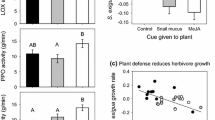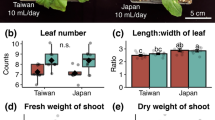Abstract
In terrestrial angiosperms, defense and resistance mechanisms against herbivores have been studied extensively; yet this topic is poorly understood in aquatic angiosperms. We investigated induced response mechanisms in Myriophyllum spicatum to the generalist insect herbivore Acentria ephemerella in three independent experiments. Various morphological and chemical response variables were examined in grazed apical shoots and compared to undamaged controls. We further estimated plant palatability of induced and non-induced apices in choice assays, and assessed the growth response of Acentria larvae in no-choice feeding assays. Leaves of induced apices were splayed out horizontally and changed in color from green to red. The dry matter content and thus plant toughness increased by up to 19 %, but silica levels stayed constant. Induced apices exhibited a decline in chlorophyll content of up to 34 %, reflected also by a 10 % decrease in nitrogen levels, while nitrogen increased by 14 % in lower parts of grazed shoots. Also, herbivore-deterring total phenolic compounds increased by up to 20 % in apices. In choice trials, Acentria larvae strongly avoided grazed tips, and growth was reduced by 25 % on induced apices. In total, we observed five different induced resistance and defensive traits in grazed apices: changes in appearance, increased plant toughness, delocalization of N-containing metabolites, increased polyphenols, and reduced nutritional value. The observed changes prevent herbivore damage and loss of apical tissue, which are most valuable for plant fitness. Our study presents the first evidence of multiple, parallel defense strategies including constitutive and induced defense mechanisms in a freshwater angiosperm.



Similar content being viewed by others

References
Agrawal AA, Fishbein M (2006) Plant defense syndromes. Ecology 87:132–149. doi:10.1890/0012-9658(2006)87[132:PDS]2.0.CO;2
Bolser RC, Hay ME, Lindquist N, Fenical W, Wilson D (1998) Chemical defenses of freshwater macrophytes against crayfish herbivory. J Chem Ecol 24:1639–1658. doi:10.1023/a:1020816511924
Chen Y-Z, Huang S-Q (2013) Red young leaves have less mechanical defence than green young leaves. Oikos 122:1035–1041. doi:10.1111/j.1600-0706.2012.20852.x
Choi C, Bareiss C, Walenciak O, Gross EM (2002) Impact of polyphenols on the growth of the aquatic herbivore Acentria ephemerella (Lepidoptera: Pyralidae). J Chem Ecol 28:2223–2235. doi:10.1023/A:1021049332410
Cook CDK (1999) The number and kinds of embryo-bearing plants which have become aquatic: a survey. Perspect Plant Ecol Evol Syst 2:79–102. doi:10.1078/1433-8319-00066
Cooke J, Leishman MR (2011) Is plant ecology more siliceous than we realise? Trends Plant Sci 16:61–68. doi:10.1016/j.tplants.2010.10.003
Cornelissen JHC, et al. (2003) A handbook of protocols for standardised and easy measurement of plant functional traits worldwide. Aust J Bot 51:335–380. doi:10.1071/bt02124
Cronin G, Wissing KD, Lodge DM (1998) Comparative feeding selectivity of herbivorous insects on water lilies: aquatic vs. semi-terrestrial insects and submersed vs. floating leaves. Freshwater Biol 39:243–257. doi:10.1046/j.1365-2427.1998.00279
Cyr H, Pace ML (1993) Magnitude and patterns of herbivory in aquatic and terrestrial ecosystems. Nature 361:148–150. doi:10.1038/361148a0
Darnell KM, Heck KL Jr (2013) Species-specific effects of prior grazing on the palatability of turtlegrass. J Exp Mar Biol Ecol 440:225–232. doi:10.1016/j.jembe.2012.12.012
Dixon RA, Pavia NL (1995) Stress-induced phenylpropanoid metabolism. Plant Cell 7:1085–1097. doi:10.1105/tpc.7.7.1085
Elger A, Lemoine D (2005) Determinants of macrophyte palatability to the pond snail Lymnaea stagnalis. Freshwater Biol 50:86–95. doi:10.1111/j.1365-2427.2004.01308.x
Elger A, Willby NJ (2003) Leaf dry matter content as an integrative expression of plant palatability: the case of freshwater macrophytes. Funct Ecol 17:58–65. doi:10.1046/j.1365-2435.2003.00700.x
Erhard D, Pohnert G, Gross EM (2007) Chemical defense in Elodea nuttallii reduces feeding and growth of aquatic herbivorous Lepidoptera. J Chem Ecol 33:1646–1661. doi:10.1007/s10886-007-9307-0
Forbey JS, Dearing MD, Gross EM, Orians CM, Sotka EE, Foley WJ (2013) A pharm-ecological perspective of terrestrial and aquatic plant-herbivore interactions. J Chem Ecol 39:465–480. doi:10.1007/s10886-013-0267-2
Gross EM (2003) Differential response of tellimagrandin II and total bioactive hydrolysable tannins in an aquatic angiosperm to changes in light and nitrogen. Oikos 103:497–504. doi:10.1034/j.1600-0706.2003.12666.x
Gross EM, Bakker ES (2012) The role of plant secondary metabolites in freshwater macrophyte-herbivore interactions: Limited or unexplored chemical defences? In: Iason GR, Dicke M, Hartley SE (eds) The integrative role of plant secondary metabolites in ecological systems. British Ecological Society, Cambridge University Press, Sussex, pp 154–169
Gross EM, Meyer H, Schilling G (1996) Release and ecological impact of algicidal hydrolysable polyphenols in Myriophyllum spicatum. Phytochemistry 41:133–138. doi:10.1016/0031-9422(95)00598-6
Gross EM, Johnson RL, Hairston NG Jr (2001) Experimental evidence for changes in submersed macrophyte species composition caused by the herbivore Acentria ephemerella (Lepidoptera). Oecologia 127:105–114. doi:10.1007/s004420000568
Gross EM, Feldbaum C, Choi C (2002) High abundance of herbivorous Lepidoptera larvae (Acentria ephemerella Denis & Schiffermuller) on submersed macrophytes in Lake Constance (Germany). Arch Hydrobiol 155:1–21
Hempel M, Grossart HP, Gross EM (2009) Community composition of bacterial biofilms on two submerged macrophytes and an artificial substrate in a pre-alpine lake. Aquat Microb Ecol 58:79–94. doi:10.3354/ame01353
Ito K, Sakai S (2009) Optimal defense strategy against herbivory in plants: conditions selecting for induced defense, constitutive defense, and no-defense. J Theor Biol 260:453–459. doi:10.1016/j.jtbi.2009.07.002
Jeffries M (1990) Evidence of induced plant defences in a pondweed. Freshwater Biol 23:265–269. doi:10.1111/j.1365-2427.1990.tb00270.x
Karban R (2011) The ecology and evolution of induced resistance against herbivores. Funct Ecol 25:339–347. doi:10.1111/j.1365-2435.2010.01789.x
Karban R, Baldwin IT (1997) Induced responses to herbivory. University of Chicago Press, Chicago
Kempel A, Schädler M, Chrobock T, Fischer M, van Kleunen M (2011) Tradeoffs associated with constitutive and induced plant resistance against herbivory. Proc Natl Acad Sci 108:5685–5689. doi:10.1073/pnas.1016508108
Koricheva J (1999) Interpreting phenotypic variation in plant allelochemistry: problems with the use of concentrations. Oecologia 119:467–473. doi:10.1007/s004420050809
Krausse GL, Schelske CL, Davis CO (1983) Comparison of three wet alkaline methods of digestion of biogenic silica in water. Freshwater Biol 13:73–81. doi:10.1111/j.1365-2427.1983.tb00658.x
Kubanek J, Fenical W, Hay ME, Brown PJ, Lindquist N (2000) Two antifeedant lignans from the freshwater macrophyte Saururus cernuus. Phytochemistry 54:281–287. doi:10.1016/S0031-9422(00)00076-5
Lehtila K (1996) Optimal distribution of herbivory and localized compensatory responses within a plant. Vegetatio 127:99–109. doi:10.1007/bf00054851
Lemoine DG, Barrat-Segretain M-H, Roy A (2009) Morphological and chemical changes induced by herbivory in three common aquatic macrophytes. Int Rev Hydrobiol 94:282–289. doi:10.1002/iroh.200811087
Lindroth RL, Hemming JDC (1990) Responses of the gypsy moth (Lepidoptera: Lymantriidae) to tremulacin, an aspen phenolic glycoside. Environ Entomol 19:842–847
Lodge DM, Cronin G, Donk E, Froelich AJ (1998) Impact of herbivory on plant standing crop: comparisons among biomes, between vascular and nonvascular plants, and among freshwater herbivore taxa. In: Jeppesen E, Soendergaard M, Soendergaard M, Christoffersen K (eds) Structuring role of submerged macrophytes in lakes. Springer, New York, pp 149–174
Lucas PW, Turner IM, Dominy NJ, Yamashita N (2000) Mechanical defences to herbivory. Ann Bot 86:913–920. doi:10.1006/anbo 2000.1261
Meldau S, Erb M, Baldwin IT (2012) Defence on demand: mechanisms behind optimal defence patterns. Ann Bot 110:1503–1514. doi:10.1093/aob/mcs212
Miler O, Straile D (2010) How to cope with a superior enemy? Plant defence strategies in response to annual herbivore outbreaks. J Ecol 98:900–907. doi:10.1111/j.1365-2745.2010.01674.x
Miler O, Korn M, Straile D (2008) Experimental evidence for a strong influence of stickleback predation on the population dynamics and sex ratio of an aquatic moth. Fund Appl Limnol 173:187–196. doi:10.1127/1863-9135/2008/0173-0187
Morrison WE, Hay ME (2011) Induced chemical defenses in a freshwater macrophyte suppress herbivore fitness and the growth of associated microbes. Oecologia 165:427–436. doi:10.1007/s00442-010-1791-1
Müller UG, Dearing MD (1994) Predation and avoidance of tough leaves by aquatic larvae of the moth Parapoynx rugosalis (Lepidoptera: Pyralidae). Ecol Entomol 19:155–158. doi:10.1111/j.1365-2311.1994.tb00405.x
Newman RM (2004) Invited review: biological control of Eurasian watermilfoil by aquatic insects: basic insights from an applied problem. Arch Hydrobiol 159:145–184. doi:10.1127/0003-9136/2004/0159-0145
Onion A (2004) Herbivore resistance in invasive and native Myriophyllum spicatum and Myriophyllum heterophyllum. Master’s thesis. Department of Ecology and Evolutionary Biology, Cornell University, Ithaca
Orians CM, Thorn A, Gómez S (2011) Herbivore-induced resource sequestration in plants: why bother? Oecologia 167:1–9. doi:10.1007/s00442-011-1968-2
Ostrofsky M, Zettler E (1986) Chemical defences in aquatic plants. J Ecol 74:279–287. doi:jstor.org/stable/2260363
Otto C, Svensson BS (1981) How do macrophytes growing in or close to water reduce their consumption by aquatic herbivores? Hydrobiologia 78:107–112. doi:10.1007/BF00007583
Prusak AC, O’Neal J, Kubanek J (2005) Prevalence of chemical defenses among freshwater plants. J Chem Ecol 31:1145–1160. doi:10.1007/s10886-005-4253-1
Riis T, Madsen TV, Sennels RSH (2009) Regeneration, colonisation and growth rates of allofragments in four common stream plants. Aquat Bot 90:209–212. doi:10.1016/j.aquabot.2008.08.005
Salminen JP, Karonen M (2011) Chemical ecology of tannins and other phenolics: we need a change in approach. Funct Ecol 25:325–338. doi:10.1111/j.1365-2435.2010.01826.x
Smith DH, Madsen JD, Dickson KL, Beitinger TL (2002) Nutrient effects on autofragmentation of Myriophyllum spicatum. Aquat Bot 74:1–17. doi:10.1016/S0304-3770(02)00023-2
Steele L, Valentine JF (2012) Idiosyncratic responses of seagrass phenolic production following sea urchin grazing. Mar Ecol Prog Ser 466:81–92. doi:10.3354/meps09921
Toth GB, Pavia H (2000) Water-borne cues induce chemical defense in a marine alga (Ascophyllum nodosum). PNAS 97:14418–14420. doi:10.1073/pnas.250226997
Toth GB, Langhamer O, Pavia H (2005) Inducible and constitutive defenses of valuable seaweed tissues: consequences for herbivore fitness. Ecology 86:612–618. doi:10.1890/04-0484
Valentine JF, Blythe EF, Madhavan S, Sherman TD (2004) Effects of simulated herbivory on nitrogen enzyme levels, assimilation and allocation in Thalassia testudinum. Aquat Bot 79:235–255. doi:10.1016/j.aquabot.2004.04.001
Van Alstyne KL, Pelletreau KN (2000) Effects of nutrient enrichment on growth and phlorotannin production in Fucus gardneri embryos. Mar Ecol Prog Ser 206:33–43. doi:10.3354/meps206033
Walenciak O, Zwisler W, Gross EM (2002) Influence of Myriophyllum spicatum-derived tannins on gut microbiota of its herbivore Acentria ephemerella. J Chem Ecol 28:2045–2056. doi:10.1023/A:1020754012785
Acknowledgments
This work was funded by the Deutsche Forschungsgemeinschaft (DFG) within the collaborative research center CRC454 Littoral of Lake Constance, project A2 to E. M. G. We greatly acknowledge Alene Onion, whose M.Sc. thesis, and Robert L. Johnson, whose field and greenhouse observations, stimulated the design of these experiments. We thank Claudia Feldbaum, Christine Ziese, Simone Wörner and Silas Bossart for assistance in the field and laboratory. Mark van Kleunen commented on a prior version of this manuscript.
Author information
Authors and Affiliations
Corresponding author
Additional information
Communicated by Colin Mark Orians.
Electronic supplementary material
Below is the link to the electronic supplementary material.
Rights and permissions
About this article
Cite this article
Fornoff, F., Gross, E.M. Induced defense mechanisms in an aquatic angiosperm to insect herbivory. Oecologia 175, 173–185 (2014). https://doi.org/10.1007/s00442-013-2880-8
Received:
Accepted:
Published:
Issue Date:
DOI: https://doi.org/10.1007/s00442-013-2880-8



